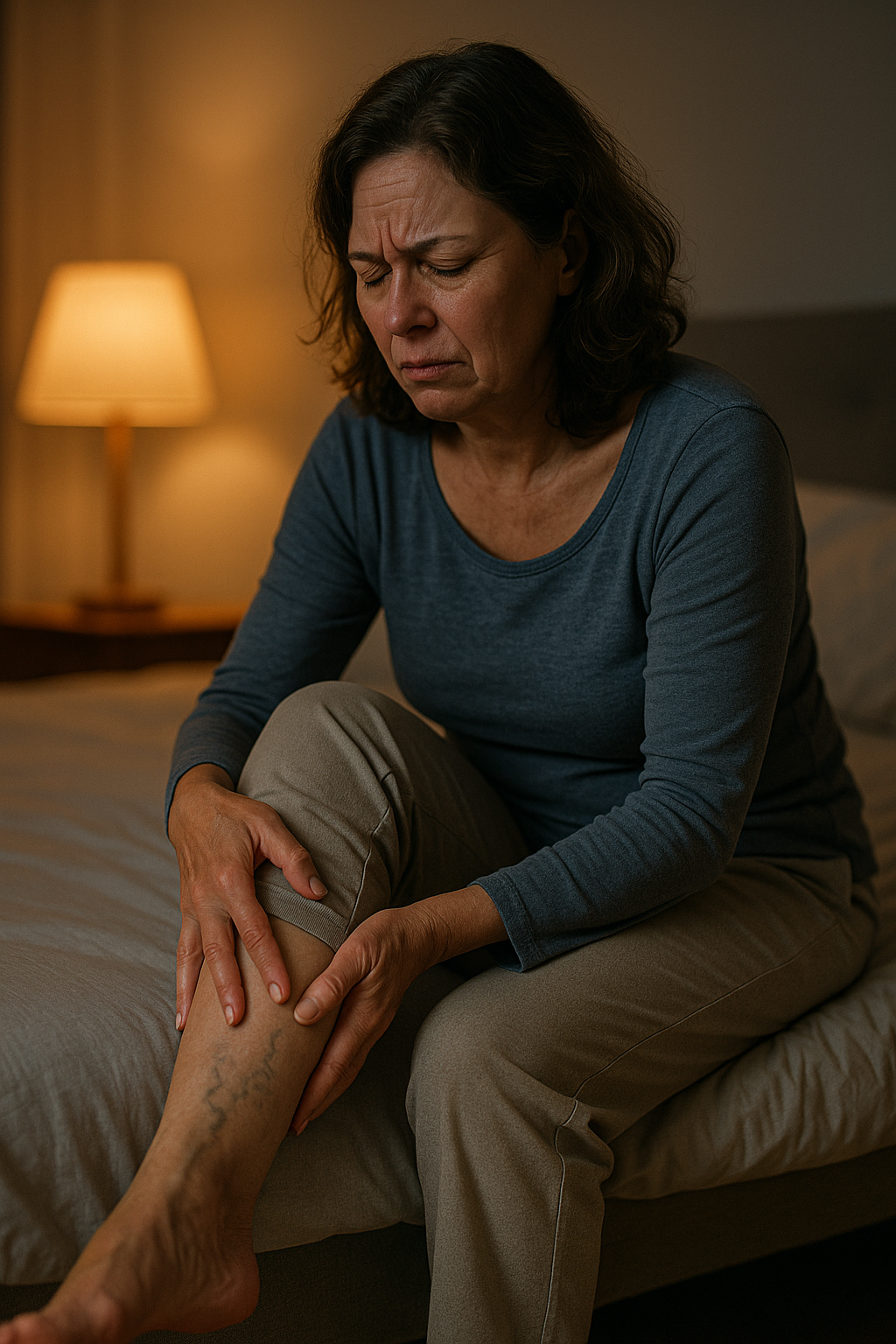Restless Leg Syndrome and Vein Disease: What’s the Connection?

Introduction
Restless leg syndrome (RLS) is a frustrating and often misunderstood condition. If you find yourself battling irresistible urges to move your legs—especially at night—you’re not alone. Millions of people suffer from RLS, and many are told it’s a neurological issue or are given medications to manage symptoms.
But there’s more to the story.
Recent studies and clinical experience show a surprising connection between restless leg syndrome and chronic vein disease. In many cases, treating underlying venous insufficiency can dramatically reduce or even eliminate RLS symptoms—without the need for long-term medications.
In this blog, we’ll explore:
- What restless leg syndrome really is
- What causes RLS from a functional perspective
- The connection between RLS and vein disease
- How vein treatment can relieve restless legs
- What to do if you suspect your veins are part of the problem
What Is Restless Leg Syndrome?
Restless leg syndrome (RLS), also called Willis-Ekbom Disease, is a neurological condition characterized by:
- An uncontrollable urge to move the legs
- Tingling, itching, or “creepy-crawly” sensations
- Symptoms that worsen at rest or in the evening
- Relief with movement (walking, stretching, pacing)
- Difficulty falling asleep or staying asleep
Although it’s commonly labeled a brain or dopamine imbalance, many people experience RLS as part of a broader issue involving circulation, inflammation, and tissue dysfunction—especially in the lower legs.
Common Risk Factors for RLS
- Iron deficiency or anemia
- Peripheral neuropathy
- Chronic kidney disease
- Parkinson’s disease
- Diabetes or insulin resistance
- Pregnancy (due to hormonal and circulatory changes)
- Chronic venous insufficiency (vein disease)
What’s often missed is that poor circulation and blood pooling in the legs—due to dysfunctional veins—can mimic or trigger RLS symptoms.
What Is Vein Disease?
Chronic venous insufficiency (CVI) is a condition where the veins in your legs struggle to send blood back up toward the heart. Over time, valves in the veins become weak or damaged, allowing blood to pool in the lower legs.
This leads to symptoms such as:
- Leg heaviness or fatigue
- Swelling (especially at the end of the day)
- Aching, cramping, or throbbing legs
- Burning or itching sensations
- Visible varicose or spider veins
- Skin changes (darkening, thickening)
- Restless legs or nighttime leg discomfort
Sound familiar? That’s because many symptoms of restless legs overlap with vein disease.
The RLS–Vein Disease Connection: What the Research Shows
Several studies and clinical reports support the link between venous insufficiency and restless leg symptoms:
✅ A 2008 study published in Phlebology found that over 20% of RLS patients also had venous reflux (a sign of vein disease). Treating the vein reflux reduced or resolved RLS symptoms in most of these patients.
✅ Another study in Dermatologic Surgery observed that after sclerotherapy or ablation procedures, many patients with RLS reported significant improvement in their leg restlessness.
✅ In practice, vein specialists frequently hear from patients that their “restless legs went away” after treating varicose veins or venous reflux.
Why does this happen?
Because poor vein function causes increased pressure, inflammation, and oxygen depletion in the leg tissues—especially when lying down. This can create the tingling, twitching, and urge to move associated with RLS.
Signs Your RLS May Be Related to Vein Disease
If you answer “yes” to several of these, your RLS may be circulation-related:
- Do your legs feel heavy, achy, or swollen at the end of the day?
- Do your symptoms worsen when you’re sitting or lying down?
- Do you have visible varicose or spider veins?
- Do you frequently elevate your legs for relief?
- Do you get nighttime leg cramps or “jumpy legs”?
- Does walking or stretching bring relief—temporarily?
If you’ve tried medications for RLS without relief, or you’re looking for a root-cause solution, it’s time to get your veins evaluated.
How Vein Treatment Can Relieve Restless Legs
The goal of vein treatment is to improve circulation and reduce blood pooling, inflammation, and pressure in the legs.
Common treatments include:
Ultrasound-Guided Vein Evaluation
A simple, non-invasive scan that checks for venous reflux or valve dysfunction. It’s the first step to determine if your RLS symptoms are vein-related.
Endovenous Ablation (Laser)
A minimally invasive procedure that seals off faulty veins, redirecting blood flow to healthy ones. Takes under an hour and requires no downtime.
Sclerotherapy
A solution is injected into spider or small varicose veins to collapse and fade them. May help reduce surface irritation contributing to restlessness.
Compression Therapy
Medical-grade compression stockings improve circulation and reduce swelling—often providing immediate relief of RLS symptoms.
Many patients report that after treating their veins, they sleep better, stop needing to move their legs constantly, and feel significantly more comfortable at night.
Functional Medicine Tips for Supporting Vein and Nerve Health
In addition to vein procedures, a root-cause approach looks at:
- Iron and ferritin levels (low iron is linked to RLS)
- Magnesium deficiency, which can worsen muscle twitching
- Hydration and electrolytes, especially if you cramp at night
- Anti-inflammatory nutrition to reduce vein irritation
- Blood sugar balance, as insulin resistance worsens both vein and nerve issues
- Movement and circulation support, like walking, stretching, or elevating legs
Final Thoughts
Restless leg syndrome can disrupt sleep, impact your mood, and affect your quality of life. While it’s often treated as a neurological condition, many cases are actually linked to underlying vein disease—a highly treatable condition.
If your legs feel jumpy, tingly, or restless—especially at night—and you also deal with swelling, cramping, or visible veins, don’t ignore the signs. A simple vein screening may uncover the missing link to your symptoms.
At Sheen Vein & Cosmetics, we specialize in diagnosing and treating vein disease—and we’ve helped countless patients find relief from restless legs through non-surgical, state-of-the-art therapies.
Schedule a vein evaluation today and discover if poor circulation is the hidden cause behind your restless legs. Relief might be easier—and more lasting—than you think.